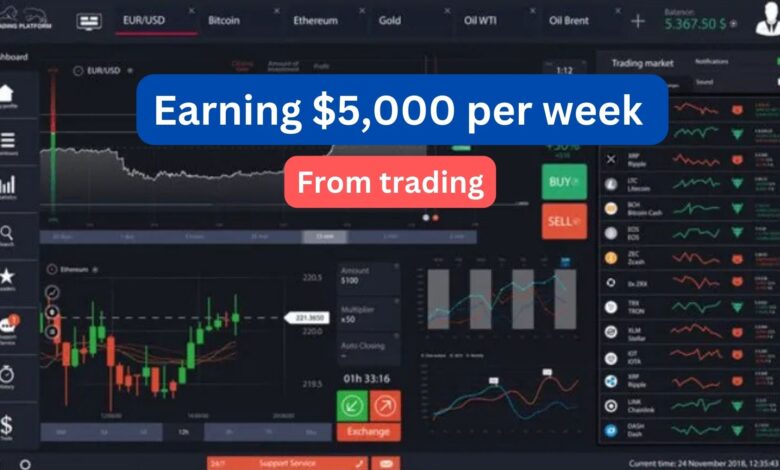Earn $5,000 per Week from Trading.

Trading offers lucrative opportunities for those who can navigate the markets effectively, but earning $5,000 per week is no small feat. This goal requires substantial capital, strategic planning, and a deep understanding of the market. While many traders have achieved consistent profitability, it’s essential to understand that this path is not without risks. Below, we will explore how you could aim to earn $5,000 per week from trading, focusing on the necessary prerequisites, strategies, and risk management techniques.
1. Set Realistic Expectations and Understand Capital Requirements
To earn $5,000 per week from trading, it’s crucial to understand that you will need a significant amount of starting capital. Trading, whether it’s in stocks, options, futures, or forex, typically yields profits as a percentage of your investment. For example, if you aim for a 1-2% return on capital weekly, you would need between $250,000 and $500,000 in trading capital to hit that $5,000 target.
However, smaller accounts can also scale to this goal over time, but it might take several months or years of consistent returns and compounding to get there. Leverage in forex or futures markets can accelerate this process, but also increases risk.
2. Master a Trading Strategy
To consistently earn $5,000 per week, you need to focus on a well-defined trading strategy. Several proven strategies have helped traders generate consistent profits, though they all require deep understanding, practice, and adjustment to market conditions.
Day Trading: This involves buying and selling securities within the same trading day. To achieve high daily returns, you’ll need to quickly analyze market trends, news, and technical indicators. Day traders capitalize on small price movements and typically make multiple trades per day.
Swing Trading: Swing traders hold positions for days or even weeks to capture medium-term price movements. This strategy is less stressful compared to day trading and allows for larger moves, which could yield the $5,000 per week target if executed correctly.
Scalping: Scalpers focus on short-term trades, holding positions for minutes or even seconds, aiming to make small profits multiple times a day. High-frequency trading like this requires excellent technical analysis skills and the ability to act quickly.
Options Trading: If you have experience in options, trading strategies like iron condors, covered calls, or credit spreads can provide significant weekly income when done properly. Options have the advantage of built-in leverage, allowing traders to control larger positions with smaller amounts of capital, potentially increasing profitability.
Cryptocurrency Trading: Cryptos like Bitcoin and Ethereum are highly volatile, making them attractive for traders who thrive in dynamic markets. However, volatility comes with increased risk, so risk management is critical.
3. Use Technical and Fundamental Analysis
Successful traders rely on a combination of technical and fundamental analysis to make informed decisions.
Technical Analysis: This involves using charts, indicators, and patterns to predict future price movements. Indicators such as moving averages, relative strength index (RSI), and MACD can provide insight into momentum, trends, and potential reversals. Mastering technical analysis helps in identifying entry and exit points.
Fundamental Analysis: This focuses on evaluating an asset’s intrinsic value by analyzing macroeconomic factors, financial statements, company performance, and market news. For long-term swing traders or options traders, this can be crucial for selecting assets with strong growth potential.
4. Leverage and Position Sizing
Leverage is a double-edged sword. It allows you to control more capital than you actually have, thus magnifying both gains and losses. For instance, in forex trading, brokers often offer leverage as high as 100:1, meaning you can control $100,000 with just $1,000 of your own money. While this can help achieve large weekly profits, it also increases your exposure to market volatility.
A disciplined approach to position sizing ensures that even with leverage, a few losing trades won’t wipe out your capital. Many professional traders recommend risking no more than 1-2% of your total capital on any given trade.
5. Risk Management is Key
Achieving consistent profitability in trading requires robust risk management practices. The goal is not just to make money, but to protect your capital from significant drawdowns.
Stop Loss Orders: Always use stop-loss orders to limit your losses in case the market moves against your trade. Setting a stop loss at a predetermined level ensures that you don’t let a small loss turn into a big one.
Position Sizing: As mentioned earlier, controlling the size of your positions relative to your account is critical. The larger the trade, the more money you stand to lose if it goes wrong.
Diversification: Don’t put all your capital into a single trade or asset class. Spread your risk across different markets, sectors, or strategies to avoid losing your entire portfolio in one bad trade.
6. Automated Trading and Algorithms
Many professional traders use automated trading systems to execute their strategies without emotion. These systems follow predefined rules, executing trades based on technical indicators or price action patterns. You can either build your own algorithm if you have programming skills or buy one from a reputable developer.
These systems can help you maintain discipline, particularly in volatile markets, by sticking to your strategy without letting emotions like fear or greed influence your decisions.
7. Develop a Routine and Stay Informed
A successful trader follows a strict daily routine. The markets are constantly changing, so it’s vital to stay informed about current events, economic indicators, earnings reports, and geopolitical developments. This can help you adapt your strategy as market conditions shift.
In addition, review your trades regularly. Analyze what went well, what didn’t, and make adjustments to improve your performance over time.
8. Control Emotions and Stick to Your Plan
The psychological aspect of trading is often overlooked, but it is one of the most critical factors in long-term success. Fear, greed, and overconfidence can lead to impulsive trades, which could wipe out your gains. To combat this, create a well-defined trading plan and stick to it, no matter how tempting it might be to deviate.
Conclusion
Earning $5,000 per week from trading is possible, but it requires dedication, significant capital, a solid trading strategy, and strict risk management. By mastering a specific trading style—whether it be day trading, swing trading, or options trading—and using tools like technical analysis, leverage, and automated systems, traders can achieve consistent returns. However, the importance of discipline, emotional control, and continuous learning cannot be overstated.
Before embarking on this journey, it’s critical to assess your risk tolerance, develop a comprehensive trading plan, and ensure that you have the knowledge and tools necessary to succeed in the highly competitive world of trading.



